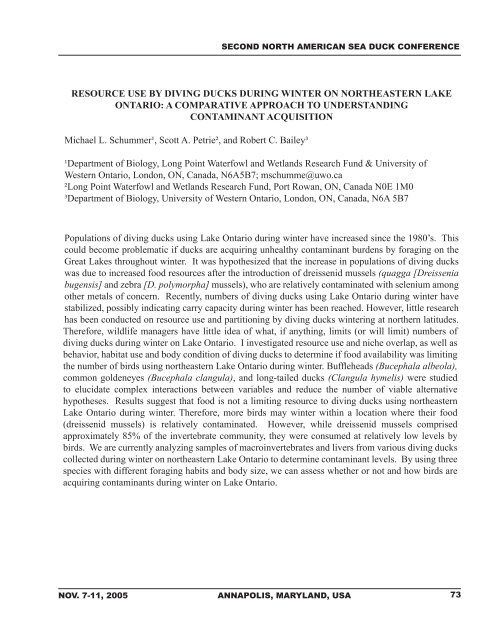Second North American Sea Duck Conference - Patuxent Wildlife ...
Second North American Sea Duck Conference - Patuxent Wildlife ...
Second North American Sea Duck Conference - Patuxent Wildlife ...
You also want an ePaper? Increase the reach of your titles
YUMPU automatically turns print PDFs into web optimized ePapers that Google loves.
SECOND NORTH AMERICAN SEA DUCK CONFERENCE<br />
RESOURCE USE BY DIVING DUCKS DURING WINTER ON NORTHEASTERN LAKE<br />
ONTARIO: A COMPARATIVE APPROACH TO UNDERSTANDING<br />
CONTAMINANT ACQUISITION<br />
Michael L. Schummer¹, Scott A. Petrie², and Robert C. Bailey³<br />
¹Department of Biology, Long Point Waterfowl and Wetlands Research Fund & University of<br />
Western Ontario, London, ON, Canada, N6A5B7; mschumme@uwo.ca<br />
²Long Point Waterfowl and Wetlands Research Fund, Port Rowan, ON, Canada N0E 1M0<br />
³Department of Biology, University of Western Ontario, London, ON, Canada, N6A 5B7<br />
Populations of diving ducks using Lake Ontario during winter have increased since the 1980’s. This<br />
could become problematic if ducks are acquiring unhealthy contaminant burdens by foraging on the<br />
Great Lakes throughout winter. It was hypothesized that the increase in populations of diving ducks<br />
was due to increased food resources after the introduction of dreissenid mussels (quagga [Dreissenia<br />
bugensis] and zebra [D. polymorpha] mussels), who are relatively contaminated with selenium among<br />
other metals of concern. Recently, numbers of diving ducks using Lake Ontario during winter have<br />
stabilized, possibly indicating carry capacity during winter has been reached. However, little research<br />
has been conducted on resource use and partitioning by diving ducks wintering at northern latitudes.<br />
Therefore, wildlife managers have little idea of what, if anything, limits (or will limit) numbers of<br />
diving ducks during winter on Lake Ontario. I investigated resource use and niche overlap, as well as<br />
behavior, habitat use and body condition of diving ducks to determine if food availability was limiting<br />
the number of birds using northeastern Lake Ontario during winter. Buffleheads (Bucephala albeola),<br />
common goldeneyes (Bucephala clangula), and long-tailed ducks (Clangula hymelis) were studied<br />
to elucidate complex interactions between variables and reduce the number of viable alternative<br />
hypotheses. Results suggest that food is not a limiting resource to diving ducks using northeastern<br />
Lake Ontario during winter. Therefore, more birds may winter within a location where their food<br />
(dreissenid mussels) is relatively contaminated. However, while dreissenid mussels comprised<br />
approximately 85% of the invertebrate community, they were consumed at relatively low levels by<br />
birds. We are currently analyzing samples of macroinvertebrates and livers from various diving ducks<br />
collected during winter on northeastern Lake Ontario to determine contaminant levels. By using three<br />
species with different foraging habits and body size, we can assess whether or not and how birds are<br />
acquiring contaminants during winter on Lake Ontario.<br />
NOV. 7-11, 2005 ANNAPOLIS, MARYLAND, USA<br />
73












